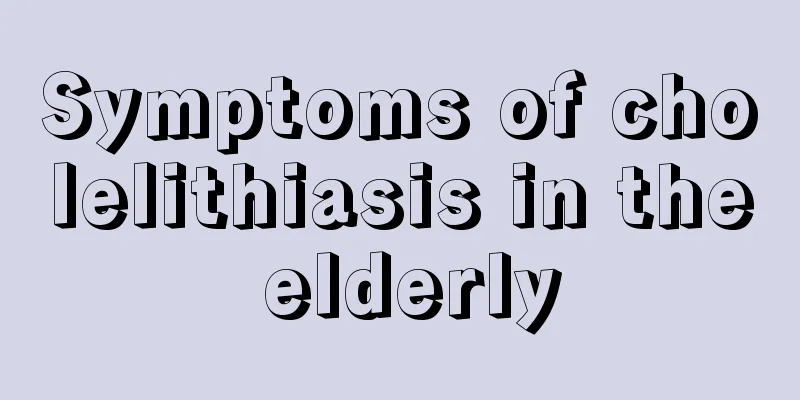Symptoms of cholelithiasis in the elderly

|
Pain is a feeling that everyone hates the most. Even a small cut on the hand is very uncomfortable, but the pain suffered when you are sick is definitely the most distressing. Among them, the most distressing are various stones. Many people roll around in pain at night and can't even sleep well. For the elderly, suffering from senile cholelithiasis is like a nightmare, but most people delay seeking medical treatment because they are not aware of the symptoms of senile cholelithiasis. So what are the symptoms of cholelithiasis in the elderly? Many family members know little about the care of their elderly parents after they suffer from cholelithiasis, but for those who have elderly parents suffering from this disease, it is very necessary to understand these issues. 1. Typical symptoms (1) Biliary colic or upper abdominal pain: About 75% of patients with symptomatic stones seek medical attention due to biliary colic. Biliary colic is a visceral pain, most often caused by temporary obstruction of the cystic duct by stones. The main symptoms are paroxysmal upper abdominal pain, often located in the right upper abdomen or upper abdomen. In severe cases, it manifests as colic, and the pain often radiates to other parts of the abdomen or the back, scapular area and right shoulder. The pain may be aggravated by eating and often occurs at night. (2) Chills and fever: When acute cholecystitis occurs, chills and fever are common. When hydrops in the gallbladder are secondary to bacterial infection to form gallbladder abscesses or gangrene and perforation, chills and high fever are more obvious. (3) Gastrointestinal symptoms: Most patients with gallstones may experience nausea and vomiting during biliary colic, and biliary colic often improves to a certain extent after vomiting. (4) Jaundice: Simple gallstones do not cause jaundice. About 75% of patients with common bile duct stones may develop jaundice 12 to 24 hours after experiencing upper abdominal pain, chills, and high fever because the stones stuck in the ampulla of Vater cannot be loosened or the common bile duct obstruction cannot be relieved. (5) Cholecardiac syndrome: When biliary colic occurs simultaneously with myocardial ischemia, angina pectoris or myocardial infarction, it is called cholecardiac syndrome. (6) Mirizzi syndrome: Large stones that continuously impact or compress the ampulla and neck of the gallbladder may cause common hepatic duct stenosis or cystic duct fistula. Recurrent cholecystitis, cholangitis, and obstructive jaundice are called Mirizzi syndrome. Clinical manifestations include recurrent mild or moderate right upper abdominal pain, accompanied by fever and jaundice. (7) Clinical manifestations of acute suppurative cholangitis: Immediate bile duct obstruction that cannot be relieved and is accompanied by severe bile duct infection often leads to acute suppurative cholangitis, which manifests as clinical manifestations of systemic poisoning such as hypotension, toxic shock and sepsis. 2. Asymptomatic Bile duct stones are almost inevitably associated with symptoms, whereas approximately 50% of patients with simple gallbladder stones may be asymptomatic. Sometimes, gallstones are discovered accidentally during abdominal X-ray or B-ultrasound examinations. 3. Atypical symptoms Elderly patients often have atypical clinical manifestations due to their slow reaction, low physiological function and poor body response ability. They often have mild abdominal pain without colic, or even just upper abdominal discomfort. Some patients do not have chills or high fever when they have severe biliary infection, and a few even have no temperature rise. When the body temperature is below 36°C, it indicates a poor prognosis. 4. Typical signs Some patients with simple gallbladder stones may feel slight pressure in the right upper abdomen during physical examination. 5. Atypical signs Some elderly patients with cholelithiasis often have no obvious tenderness in the upper abdomen, only mild discomfort, or even severe infection. |
>>: Symptoms of low blood pressure in the elderly
Recommend
What to do if the blood test for iron deficiency anemia is abnormal
Iron deficiency anemia is a common symptom of ane...
How long can you live after being diagnosed with stomach cancer
Many gastric cancer patients are worried about th...
Should teratoma undergo surgery?
We know that surgery can be used to treat teratom...
What are the dangers of homemade facial masks
There are many benefits to making your own facial...
How long can you live with dialysis three times a week
As we all know, dialysis is only necessary for ma...
Can persimmon and garlic be eaten together
It is the time to eat persimmons in autumn. Sweet...
Can I drink red wine if it has sediment?
Red wine is a type of wine that many people like ...
The correct way to eat Panax notoginseng leaves
What is the correct way to eat Panax notoginseng ...
What is normal intraocular pressure?
The normal intraocular pressure range is 10-21 mm...
Beware! Genetics is also one of the causes of breast cancer
According to a survey, about 1.28 million women w...
Is sesame paste good for calcium supplementation?
Sesame paste is a food we often eat. There are ma...
Why do I eat less but poop more?
It is necessary for the body to supplement certai...
What diseases will teenagers get if they lack calcium
Many mothers are afraid that their children will ...
What are the early symptoms of lymphoma
Lymphoma, also known as lymphoma, is a malignant ...
Pimples appear under the nose and above the lips
No matter where acne appears, it is a very frustr...









